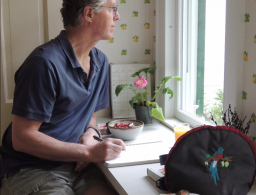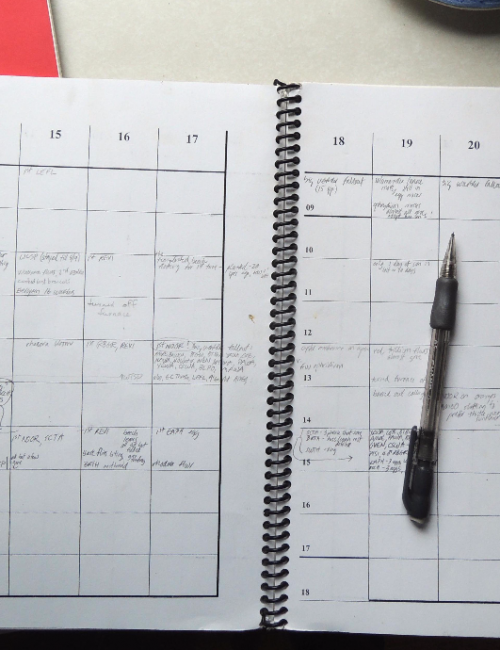The Naturalist's Notebook: Making Everyday Connections to Nature through Journal-Keeping
By Tom Porter





For nature lovers there are certain key events that shape your year: hearing the first songbird in spring, the arrival of monarch butterflies in the summer, the first snowfall in winter (or earlier sometimes), the list goes on.
Anne T. and Robert M. Bass Professor of Natural Sciences Nathaniel T. Wheelwright wants to encourage more people to notice the world around them. To this end, he devised The Naturalist’s Notebook (Storey Publishing, 2017), which he co-authored with Bernd Heinrich, Emeritus Professor of Biology at the University of Vermont and award-winning nature writer (he’s also a talented artist).
To celebrate the publication of The Naturalist’s Notebook, Professor Wheelwright, with the help of colleagues at Bowdoin News, has produced a series of short videos called ‘Nature Moments,’ to help people notice the world around them throughout the changing seasons. We will be publishing a new video every Monday throughout the next year. Here is episode one!
Packed with colorful illustrations by Heinrich, the book contains tips on how to become a naturalist no matter what your background or where you live, and features a five-year calendar journal, enabling users to track changes in the natural world and compare field notes from year-to-year.
Wheelwright shared his thoughts on how to become an amateur naturalist and why it’s so important for people to do that.
How did this project come about?
I’ve been using this kind of approach for thirty years now: recording really simple, abbreviated observations of anything that strikes me as interesting, from snowflakes, to the rhubarb popping up, to the last corn from our garden that we ate, to the arrival of migratory birds.
I realized after a while that it’s a really good technique to teach yourself about nature, so I wanted to share that. Bernd and I hope to get as many people reconnected with nature as possible, both for the sake of preserving biodiversity, and also for the mental health benefits and the sheer pleasure that comes of being aware of where you live.
How is this different from other nature journals that are out there?
The big difference is that this is as much about pulling information out as it is about putting information in. Most nature journals are for just recording personal impressions in a diary format, and they tend to be just for one year in isolation.
Here’s the problem. If, for example, I ask you when redwing blackbirds return from migration in your backyard, you have to pull out a book from, let’s say, 1994, and thumb through it to find the data, then put it back on the shelf, get your book from 1995 and dig for the same information, and so on.
The journal at the back of our book, however, is for five years (we thought some people might find a ten-year journal a little too daunting,) and it’s set out like a spreadsheet, in grid form. If you make up your own symbols and abbreviations, that makes it easier to record and to spot things. For example, a redwing blackbird might be RWBB—and I would write “1st” next to it and maybe circle it to denote its significance. So at a glance I can tell you when redwing blackbirds reappeared in my yard over the last five or ten years.
What tips can you offer people who want to become observant naturalists?
Don’t stress about filling in the journal, it doesn’t matter if you miss a week, or even a month. On the other hand, some effort is required if you want to get something out of this. It’s important to be able to name things, even if you can only broadly classify them at first. Is it a butterfly? A beetle? A fly? Once you’ve done that, you can zero in and ID things more fully. Is it a blister beetle? Maybe it’s a ladybird beetle or a ground beetle?
There’s no shortcut to learning the names of things. It’s a vocabulary you have to learn, like learning a foreign language. However, studies do show that writing things down, in a journal like this for example, rather than typing on a keyboard, does help you remember them. Carrying a little notebook with you is also a good idea: If you jot your observations down, or make a sketch, you’re less likely to forget them. Also, I would advise you to try and befriend an experienced naturalist and learn from him or her. Learning is most fun when it’s a collaborative process.
The book also offers advice on how to conduct little experiments. These can be really simple: for example, putting up a birdhouse is an experiment, so is mowing the lawn. One experiment that Bernd performed when he found two dead mice in a mousetrap, was to put them outside on a tree stump and see what happened. Guess what? A chickadee immediately appeared and starting pulling the fur off the dead mice to line its nest!
What, above all, would you like people to get from this book?
We hope it will help people establish a healthy connection to the world around them. We’re not trying to train folks to be professional ecologists, but we do want to help them to be mindful about where they live and to get fulfillment from their surroundings.
Of course the downside to this is that being aware of your natural surroundings also makes you more aware of the unfortunate changes that are occurring due to climate change, species that are disappearing and habitats that are diminishing. That can be a little depressing, but it is more than compensated by the sheer joy of noticing little daily surprises in nature, and of being truly aware of where you live.



